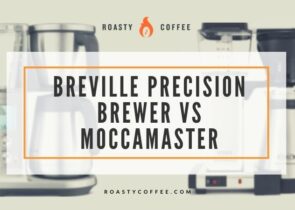From a country rich in natural resources and culture, Nicaraguan coffee is one of the top joes on the market. Nicaragua has a lot to offer a coffee lover, from producing plenty of shade-grown products to being full of Fair Trade co-ops to a not-so-little something called elephant beans.
At a Glance: Best Nicaraguan Coffee

Quick Summary: Best Nicaraguan Coffee
 | Our Top Pick Lifeboost Coffee - Medium Roast |
| Check Price → |
 | Alma Coffee - Slumber Decaf |
| Check Price → |
 | Caffe Vita - Nicaragua La Bendicion |
| Check Price → |
 | Máquina Coffee Roasters - Nicaragua La Estrella |
| Check Price → |
 | Huckleberry Roasters - Nicaragua Entre Rios |
| Check Price → |
 | Red Rooster Coffee - Funky Chicken Blend |
| Check Price → |
 | Good Citizen Coffee Co. - Nueva Segovia |
| Check Price → |
 | Alma Coffee - Slumber Decaf |
| Check on Amazon → |
 | RED ROOSTER COFFEE ORGANIC NICARAGUA |
| Check Price → |
 | TINY FOOTPRINT COFFEE NICARAGUA SEGOVIA |
| Check on Amazon → |
Notes on Nicaragua
Even though 1796 saw the first coffee plant take hold in Nicaraguan soil, large-scale coffee production didn’t begin in the Central American country until the 1850s. The coffee industry remained a cornerstone of the Nicaraguan economy over the next 150 years, but not without a few ups and downs.
During the 20th century, government emphasis shifted toward quantity in crop yields, damaging Nicaragua’s reputation for producing high-quality coffee beans. Additionally, ongoing sociopolitical tensions often disrupt Nicaraguan coffee production. External factors — natural disasters, U.S. interference, etc. — have also impeded the success of the Nicaraguan coffee industry.

There’s good news, however: the tenacity of Nicaraguan coffee farmers prevails over the challenges they face, and they have been able to more or less maintain the successful production of top-notch joe.
Roasty Rankings: Our Picks for the Best Nicaraguan Coffee
So, what are the best coffee beans Nicaragua has to offer? Read on to find out more about the best Nicaraguan coffee!
Lifeboost Coffee – Medium Roast

Lifeboost Medium Roast Coffee
Lifeboosts Medium Roast blend is another blend that’s non-GMO, low in acidity, and has hints of sweet cocoa, with an undertone of a robust, woodsy flavor. The certified beans are hand-selected for purity, hand-washed, and sun-dried to remove harmful moisture content.
We at Roasty are big fans of Lifeboost coffee beans, and once you discover all this joe has to offer, you might jump on the bandwagon, too. The mountainous regions of Nicaragua are known for producing drool-worthy coffee beans, and the 100-percent arabica joe from Lifeboost is no exception.
Factors like the ideal climate and deliberate production protocols — shade-growing, hand-picking, spring water-washing, and sun-drying the beans before roasting them — create great-tasting coffee.
Even better than the taste of this coffee is that Lifeboost beans have a low acidity level, making them sensitive stomach approved; low-acid coffee enthusiasts, keep Lifeboost in mind the next time you buy beans.
Not only that, but they are third-party tested for mycotoxins, mold, heavy metals, and pesticides. Brew these coffee grounds with your method of choice, and soon enough, you’ll be drinking the cleanest cup possible.
Alma Coffee – Slumber Decaf

Alma Coffee - Slumber Decaf
If you’re looking for a batch of beans grown in Central America — in Nicaragua’s Matagalpa region, to be exact — but lacking caffeine, check out Alma Coffee’s Slumber decaf. Since it’s free of the natural stimulant, it won’t keep you up all night, so a cup of this light-medium roast makes a perfect after-dinner treat.
This joe’s raisin, sweet orange, and chocolate syrup tasting notes create a smooth and sweet brew. Though you can use any brewing method to prepare this coffee, you might find it fares particularly well in your cold brew maker or espresso machine. Whether you want to drink it black or add a splash of milk or creamer, Alma’s Slumber coffee does a great job meeting your caffeine-free needs.
Caffe Vita – Nicaragua La Bendicion

Caffe Vita - Nicaragua La Bendicion
Did you know the word vita means life? The Seattle-based company knows relationships make life better, so Caffe Vita has been using coffee to build connections and make life more fulfilling since 1995.
The next time you plan to spend quality time with the people most important to you, bring out a bag of Caffe Vita’s Nicaragua La Bendicion. The sweet-tasting lighter roast, complete with delicious notes of lemon, peach, and black tea, offers an all-around pleasant sipping experience.
These beans come from a varietal of coffee plants called Pacamara, a hybrid of two arabica varieties (Pacas and Maragogype) known for producing a cup filled with exceptional coffee flavor and intense yet lovely aroma.
Máquina Coffee Roasters – Nicaragua La Estrella

Máquina Coffee Roasters - Nicaragua La Estrella
Pleasant, approachable, and delicious, this smooth cup features a gentle, nutty sweetness with just a hint of fruity acidity.
Though Nicaraguan coffee tends to be on the fruitier side of the flavor spectrum, Máquina’s Nicaragua La Estrella beans are sweeter. The joe, produced by Nueva Segovia smallholders, has dark sugar and caramel notes, plus a subtle hint of citrus.
Some have said these Central American coffee beans remind them of a candy bar, so if you’re determined to satisfy a sugar craving without turning to sugar, a batch of these beans may be your dream come true.
We also appreciate Máquina Coffee’s core belief: anyone can buy quality coffee and directly support the world’s coffee producers. This company shares beans not just from Nicaragua but all over the world. It is also committed to taking care of the land, improving farming practices while holding onto traditional methods, and being excited about the work other people put into producing good joe.
Huckleberry Roasters – Nicaragua Entre Rios

Huckleberry Roasters - Nicaragua Entre Rios
A rich body and fudgy sweetness are complemented by notes of black cherry in this deliciously classic combination of flavors.
Another Nueva Segovia offering, Huckleberry Roasters’ Nicaragua Entre Rios is a light-medium roast with delicious notes of crisp apple, black cherry, almond, and chocolate. These beans create a cozy, sweet, and inviting brew, perfect for sipping while you curl up on the couch and read a good book. But don’t worry; it can still give you a kick in the pants strong enough to push you through a busy day.
These beans are well taken care of through every processing step, from production by Alberto Ramos at his farm Finca Entre Rios to roasting at Huckleberry’s Denver, Colorado headquarters. Rest assured knowing that everyone involved in creating what might become your new favorite coffee is skilled in their craft and cares about delivering quality.
Red Rooster Coffee – Funky Chicken Blend

Red Rooster Coffee - Funky Chicken Blend
We want to note right off the bat that this isn’t a single-origin coffee. It’s a blend of Central American and Indonesian beans that, according to Red Rooster, creates a brew that can please a diverse range of coffee fanatics.
The Funky Chicken blend’s unique and complex flavor profile comes from using three joes and roasting them to three different levels. That means you get all the signature sweetness and bright acidity of a medium roast and the smooth, earthy mouthfeel of a dark roast bundled up in one tiny medium-roasted package.
A cup of this stuff has notes of dark chocolate and a pleasant citrus finish. Those flavors will be best brought out by a pour-over dripper, as this brewing method offers more intricate flavor extraction than your standard drip machine.
However, if you don’t have a pour-over brewer at home (and you really should, especially if you want to brew drip joe rivaling the java from your favorite coffee shops), these beans will bode well in any brewer you have.
Good Citizen Coffee Co. – Nueva Segovia

Good Citizen Coffee Co. - Nueva Segovia
Boasting a big body and dark chocolaty structure, this cup features a brown sugary sweetness alongside cozy notes of roasted nuts.
They may be tiny, but the beans in a bag of Nueva Segovia coffee pack a big punch. Smallholder farmers produce these beans in a region of Nicaragua known for high-quality joe. Then, they make their way to Nashville, where roasters at Stay Golden Coffee Co. work to ensure the coffee’s integrity and chocolate and nut flavors are maintained as it undergoes the roasting process.
When we think of sipping this medium-dark brew, we think of being snuggled up under a blanket with a piping hot cup of the sweet stuff in hand. But of course, just because the coffee gives off such a cozy feel doesn’t mean you have to wait for the colder weather to enjoy it; this big-bodied coffee is a treat all year long!
Volcanica Organic Nicaragua Coffee
Since we think Volcanica is a trustworthy coffee brand, we couldn’t exclude its organic coffee from Nicaragua from our buying guide. Their beans are from the Selva Negra Estate in the Matagalpa region and are grown at exceptionally high altitudes (between 1350 and 1470 feet above sea level).
As a result of their careful cultivation, the brew has a great body and clean flavor, with notes of chocolate, subtle lemon, plum, and honey. Volcanica Coffee’s acidity is notably mild and sweet in these medium roasted beans with just a slight briskness.
Red Rooster Coffee – Organic Nicaragua

Red Rooster Coffee - Organic Nicaragua
Roasting dark while maintaining a distinct flavor profile takes a certain degree of wizardry. This smoky, delicious single origin knocks it out of the park.
Because we’re big fans of making the most of your coffee’s intensity, we recommend you pull out your trusty French press or pour-over brewer for this bag of beans; this roast has flavors you don’t want to miss!
Red Rooster Coffee sources beans from five small farms in Jinotega, Nicaragua, to create this intense dark roast. Brew yourself a cup and drink it black to soak up all the sweet black cherry and dark chocolate tasting notes.
Tiny Footprint Coffee – Nicaragua Segovia
Are you looking for a brand of Nicaraguan coffee that puts sustainability as its top priority? Consider this offering from Tiny Footprint Coffee, the first carbon-negative coffee brand. Plus, its coffee is both fair trade and USDA organic certified.
This coffee is a 100-percent shade-grown, dark roast arabica with notes of chocolate combined with rich Nicaraguan flavors such as apricot, fig, and spice. The delightful depth of this brew is a classic example of the distinctive Nueva Segovia profile.
How does Nicaraguan coffee taste?
Like any other country with plenty of coffee farms and significant coffee exports, there is plenty of variation in Nicaraguan beans. However, there are a few notable commonalities in terms of flavor and feel you should note.
Most Nicaraguan coffee beans produce a smooth brew with a medium body and bright acidity. A cup of coffee from these beans is usually crisp with a fruity snap and an aroma marked by caramel- or chocolate-tinged sweetness. You may even smell subtle hints of citrus, too.
Nicaraguan joe’s flavor profile stands out from other Central American coffees. Beans from Guatemala, Costa Rica, Belize, and Honduras tend to be rich, more full-bodied, and have noticeable hints of chocolate (there are, of course, variances in there).
The fruity notes of light, balanced, and bright Nicaraguan joe make it most similar to Ethiopian coffee, which is pretty interesting considering the two coffee origins are entirely different continents. That shows how even seemingly insignificant growing factors can dramatically affect the taste of your coffee.
Nicaragua’s Coffee-Growing Regions
Several prominent regions spread across Nicaragua’s north, central, and western portions. While coffee grows in numerous areas, including Managua (Granada), Esteli, and Madriz, we’ll only focus on the regions that produce the highest-quality beans.
Jinotega
Most Nicaraguan coffee comes from the Jinotega region, so if you’ve ever patronized one of the many Nicaraguan coffee brands, chances are you consumed Jinotegan beans.
Jinotega, located in the country’s north-central region, boasts nutrient-rich volcanic soil and a humid, tropical climate perfect for high-quality coffee production. Favorable growing conditions aren’t the only things that make Jinotegan joe worth sipping.
Farmers in this department produce their coffees at high altitudes. Plus, these beans are shade-grown under banana or mango trees (some batches of Jinotega coffee beans lack the official shade-grown certification, though).
Matagalpa
Like Jinotega, Nicaraguan coffee farms in the Matagalpa region are also abundant in volcanic soil and have other advantageous growing conditions: a tropical and shade-heavy climate and high altitudes.
The similarities between the two locations aren’t surprising, as they’re both located in Nicaragua’s north-central region, with the Matagalpa department lying directly south of Jinotega.
Matagalpa, often called the “Pearl of the North” or the “Land of Eternal Spring,” is home to plenty of estates and cooperatives. Even though coffee production in this region hasn’t quite reached the scope of Jinotega, Matagalpa beans are still excellent.
Nueva Segovia
The next Nicaraguan region to discuss is Nueva Segovia. You’ll find this department in the northern region of the country. The coffee there typically grows on farms between 1,000 and 1,400 meters high.
This variety is known for its almond-nougat sweetness, fruity overtones, and subtle hints of chocolate. Unfortunately, Nueva Segovia coffee is significantly harder to find than Jinotega or Matagalpa joe.
Maragogype (Maragogipe)
Maragogype isn’t one of Nicaragua’s coffee-growing regions. It’s a specific Nicaraguan coffee derived from the Typica varietal of arabica coffee beans. You may hear this joe called another name, elephant beans, a title given because of the impressively large leaf, coffee cherry, and green coffee bean size. They’re the largest beans on the planet!
Maragogype coffee came from Brazil and now thrives in the Nicaraguan highlands between 2,000 and 2,500 feet above sea level. Elephant beans aren’t particularly abundant, but the joe is highly sought-after thanks to its bright acidity, nicely balanced body, and crisp, clean taste.
Elephant beans are typically medium-roasted to bring out the best of the well-rounded cup and regional variances. We should note that opinions on these beans vary widely, from “best coffee in the world” to “disappointingly underwhelming.”
Maragogype elephant bean coffee is the perfect candidate for cold brewing since this joe has an increased boost of flavor depth, and the lower acidity level created by the brewing method lets the unique profile shine.
How to Brew Nicaraguan Coffee
One of the best features of high-quality Nicaraguan coffee is its versatility. You can’t go wrong with using these beans for espresso-based drinks, like the Americano or long black, but you’ll also be satisfied running them through your basic automatic dripper.
We most enjoy Nicaraguan coffee, especially elephant beans, when cold-brewed. Cold brewing dampens the coffee’s acidic notes and allows you to enjoy its rich flavor. So, don’t be afraid to serve one of the products on our buying guide over ice — it’s the perfect summer beverage!
Not a black coffee drinker? No problem! Medium and dark roast Nicaraguan beans pair well with milk-based drinks, capable of showing up in the beverage without having their flavor drowned out by the dairy (or non-dairy milk of your choice).
Take a Chance on Nicaraguan Beans
There you have it! Despite the numerous challenges the country has faced, Nicaragua’s coffee industry remains a strong contender in the gourmet coffee market.
Next time you are in the mood for an impressive cold brew or Americano, consider checking out a coffee grown in Nicaragua to mix up your brewing routine. Whether a classic Jinotega or an adventurous elephant bean blend, who knows? Nicaraguan coffee beans might be the best coffee for your brew!
Happy Caffeinating!









